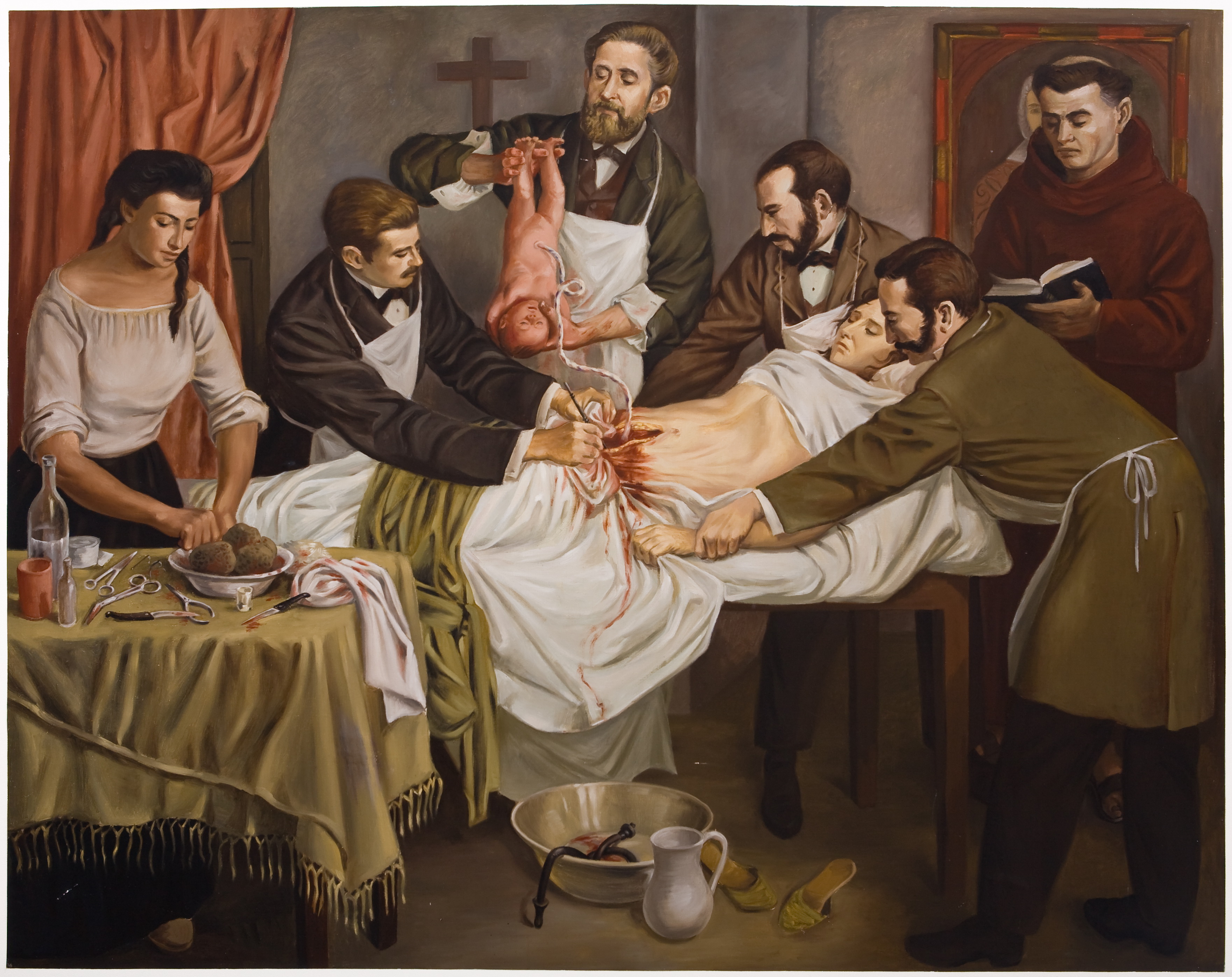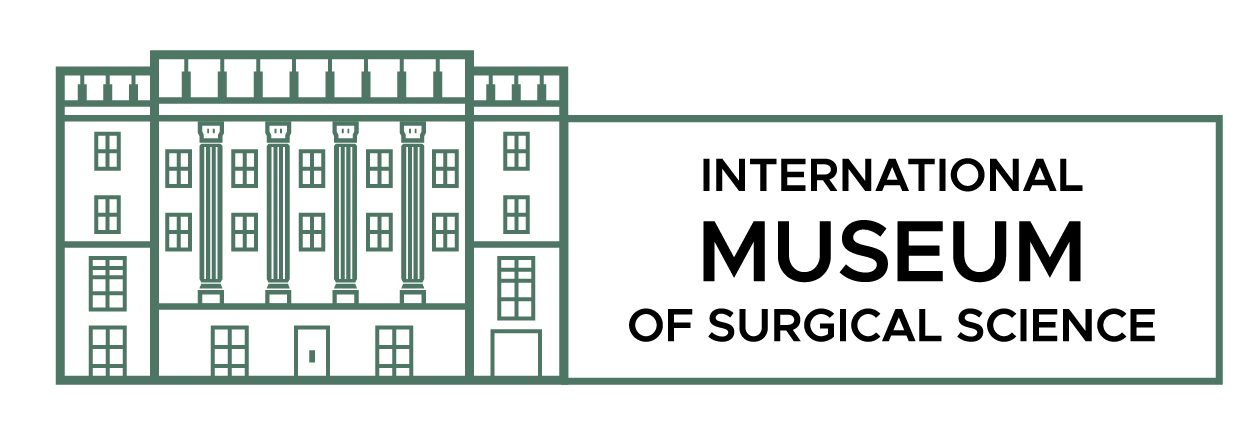Published by Anupama Suresh

Painting depicting the first successful cesarean section in Latin America in 1844. By Enrique Grau. xx1995.814.3 International Museum of Surgical Science Collection
When I first saw this painting, my eyes were drawn to the bloody abdominal incision. C-section, my brain immediately informed me. Next, my gaze shifted up the umbilical cord to the baby being held upside down by Colombian physician, Dr. Jose Ignacio Quevedo, who is depicted here performing the first successful cesarean section in Latin America in 1844. While two men hold down the patient, another is seen assisting Dr. Quevedo with the procedure. Since the dangers of C-section surgery were well known, a priest is present in the case of death of the patient. The only female professional represented in this painting is shown preparing a bowl of sea sponges soaked in a solution of ground mandrake plant – to be used as anesthesia.
This would not be a common scene if you were to walk into a delivery room today. Most of the team, including physicians, nurses, residents, would be female identifying. According to the American Medical Association in 2015, 85% of residents were female in the field of Obstetrics and Gynecology (1). However, only four decades prior to that in 1975, women made up a mere 16% of the total group of residents or physicians in training (2).
How did this field of caring for women’s health and labor change back and forth between the hands of men and women?
Let’s begin with a history of midwives in early modern Europe (1400-1800). Midwives attended to women in labor at their homes and were responsible for the safe delivery of babies. Sometimes, in the case of emergency or delayed labor, they sought the help of barber-surgeons and their instruments. Most commonly, training for midwives involved apprenticeships, with a few options for formal training at schools. However access to advanced knowledge at medical universities were denied for centuries (3).
In some European countries like England and Germany, midwives played a role in public affairs. Encouraged by the Church, they were involved in reporting illegitimate births and securing convictions for rapes and infanticides. Not pleased with their enhanced public role, measures were taken by city councils to keep the duties and salaries of midwives under their control, restricting their professional independence (3). In addition, the Church concocted an image of female healers as witches because they feared people would rely less on prayers when seeking medical help (4). On the other hand, male midwives and barber-surgeons were rising in ranks as women were losing their grasp in the medical field.
The rise in power was primarily due to the use of surgical instruments during labor. Initially, barber-surgeons were associated with death, since their presence during delivery occurred during grim situations. This view began to change with the use of forceps. The instrument provided surgeons with the opportunity to deliver babies successfully. As a result, male surgeons took control over labor and delivery. Their newfound status was boosted by the rise of science and reason during the Enlightenment era, and they were the choice of midwife by many women (3).
Use of forceps during different positions of parturition. G. Spratt, Obstetric tables: comprising coloured delineations on a peculiar plan, intended to illustrate elementary and other works on the practice of midwifery, published by John Churchill, Soho. 1833
Male physicians and surgeons dominated the medical field as long as they were the only ones to receive formal education and training. A story that stands out during this time period is that of Dr. James Barry, born Margaret Ann Bulkey, who practiced medicine during a difficult time for women interested in becoming physicians. Barry served in the military as a surgeon and performed the first successful cesarean section in South Africa in 1826 (5). Dr. James Barry lived as man and was known only by he/him pronouns throughout the course of his adult life; it was only discovered after his death that he was assigned female at birth.
It wasn’t until the late 1800’s when women were able to attend medical universities and be granted licenses to practice. As a result of the political pressures and feminist movements, schools for training women were established. More women began attending universities, and with the onset of World War I, women began entering professional fields due to labor shortages. However, the process of becoming a physician was no easier. From restrictions on married or pregnant women to quotas admitting only the smartest and oftentimes wealthiest female applicants, the male medical community continued to establish their authority in any way possible (4).
Nevertheless, as increasing numbers of women began entering the medical field, specialties like obstetrics and gynecology, saw more practicing female physicians. This then had the opposite effect on men entering the field. The reasons for decline in male OB/GYN physicians remain unclear. Theories such as increased patient demand for female physicians are commonly proposed, however research suggests that physician gender is not a primary factor in patient choice (6).
In conclusion, the shift in gender dynamics in OB/GYN history mainly revolved around access to medical education. When women achieved the freedom to study at universities, their futures looked brighter. Today, medical schools boast of their high female to male ratio among students. As this trend continues, it is also imperative that more female physicians become leaders in their fields to represent their voice in medicine.
Works Cited:
1. Vassar, L. (2015, February 18). How Medical Specialties Vary by Gender. Retrieved from https://www.ama-assn.org/residents-students/specialty-profiles/how-medical-specialties-vary-gender.
2. Craig, LB. (November 2018). To the point: gender differences in the obstetrics and gynecology clerkship. American Journal of Obstetrics and Gynecology, 219(5), 430-35. doi: 10.1016/j.ajog.2018.05.020.
3. Kontoyannis, M., Katsetos, C. (2011). Midwives in Early Modern Europe (1400-1800). Health Science Journal, 5(1), 31-36.
4. Jefferson, L., Bloor, K., Maynard, A. (June 2015). Women in medicine: historical perspectives and recent trends. British Medical Bulletin,114(1), 5–15. Doi: 10.1093/bmb/ldv007
5. Foster, S. (February 2017). Margaret Ann Bulkley (James Barry) (1789−1865). Embryo Project Encyclopedia. ISSN: 1940-5030 http://embryo.asu.edu/handle/10776/11409.
6. Gerber, SE, Lo Sasso, AT. (November 2006). The evolving gender gap in obstetrics and gynecology. American Journal of Obstetrics and Gynecology, 195(5), 1427-30. doi: 10.1016/j.ajog.2006.07.043
Anupama Suresh is a current Education Intern at the International Museum of Surgical Science. She is a medical student at The Ohio State University College of Medicine. Her interests include learning about the history of women and minorities in medicine, as well as developing skills to be an educator and physician advocate.


